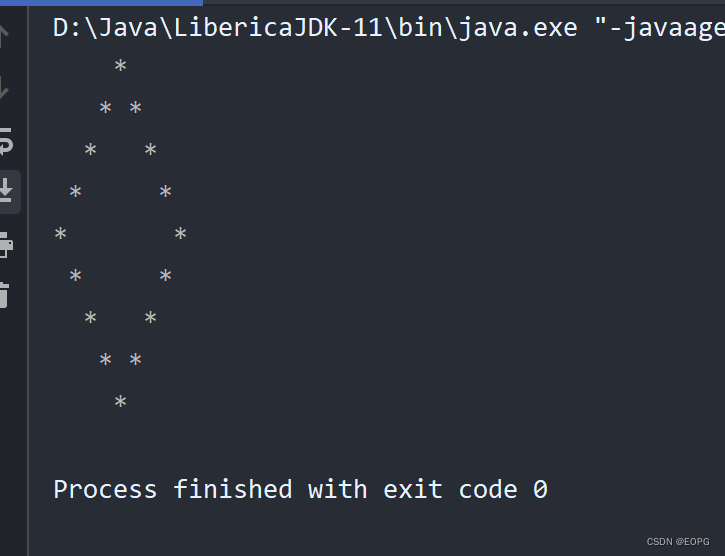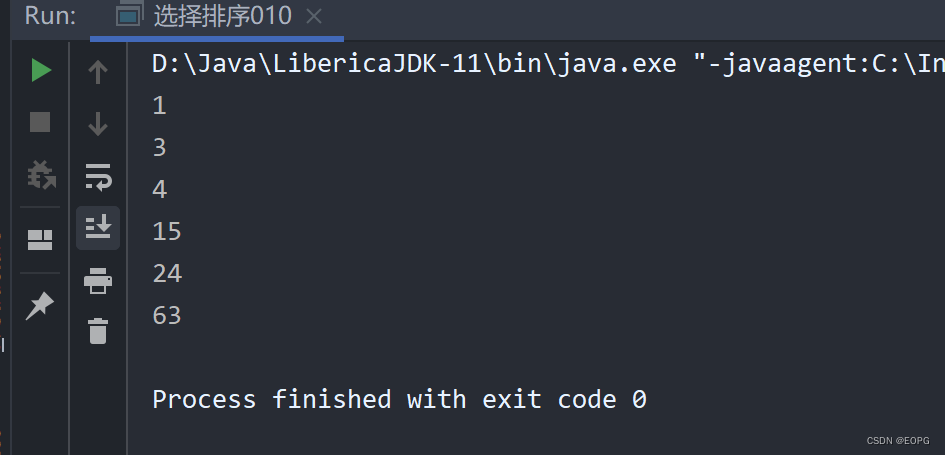Java实例程序安利006~010
006 计算阶乘(1+1/2!+1/3!+…+1/5!的和)
package com.company;
import java.math.BigDecimal;
/**
* @author 过儿
* @date 2022/5/9 0009 18:52
* @description 1+1/2!+1/3!+...+1/5!的和
*/
public class 计算阶乘006 {
public static void main(String[] args) {
//和
BigDecimal sum = new BigDecimal(0.0);
//阶乘项的计算结果
BigDecimal factorial = new BigDecimal(1.0);
//循环增量
int i = 1;
while (i <= 5) {
//累加各项阶乘的和
sum = sum.add(factorial);
//i+1
++i;
//计算阶乘项
factorial = factorial.multiply(new BigDecimal(1.0 / i));
}
//输出计算结果
System.out.println("1+1/2!+1/3!+...+1/5!的和 计算结果等于:\n" + sum);
}
}

007 空心菱形
使用两个双层for 循环分别输出菱形的上半部分与下半部分
package com.company;
/**
* @author 过儿
* @date 2022/5/10 0010 13:50
* @description
*/
public class 空心菱形 {
public static void main(String[] args) {
printHollowRhombus(8);
}
public static void printHollowRhombus(int size) {
if (size % 2 == 0) {
//计算菱形大小
size++;
}
for (int i = 0; i < size / 2 + 1; i++) {
for (int j = size / 2 + 1; j > i + 1; j--) {
//输出左上角位置的空白
System.out.print(" ");
}
for (int j = 0; j < 2 * i + 1; j++) {
if (j == 0 || j == 2 * i) {
//输出菱形上半部边缘
System.out.print("*");
} else {
//输出菱形上半部空心
System.out.print(" ");
}
}
System.out.println(" ");
}
for (int i = size / 2 + 1; i < size; i++) {
for (int j = 0; j < i - size / 2; j++) {
//输出菱形左下角空白
System.out.print(" ");
}
for (int j = 0; j < 2 * size - 1 - 2 * i; j++) {
if (j == 0 || j == 2 * (size - i - 1)) {
//输出菱形下半部边缘
System.out.print("*");
} else {
//输出菱形下半部空心
System.out.print(" ");
}
}
System.out.println(" ");
}
}
}

008 获取一维数组最小值
package com.company;
/**
* @author 过儿
* @date 2022/5/10 0010 17:24
* @description
*/
public class 获取一维数组最小值 {
public static void main(String[] args) {
int[] numbers = {
2,5,123,34,66,12,1,24};
int min = numbers[0];
for (int tem:numbers) {
if (tem < min) {
min = tem;
}
}
System.out.println(min);
}
}
009 二维数组行列互换
利用双层for循环遍历数组时,把新数组与原数组的行列索引交换进行元素赋值
package com.company;
/**
* @author 过儿
* @date 2022/5/11 0011 14:11
* @description
*/
public class 二维数组行列互换009 {
public static void main(String[] args) {
//创建二维数组
int[][] arr = new int[][]{
{
1, 2, 3}, {
4, 5, 6}, {
7, 8, 9}};
System.out.println("行列互调前:");
//输出二维数组
printArray(arr);
int[][] arr2 = new int[arr.length][arr.length];
//调整数组行列数据
for (int i = 0; i < arr.length; i++) {
for (int j = 0; j < arr[i].length; j++) {
arr2[i][j] = arr[j][i];
}
}
System.out.println("行列互调后:");
//输出二维数组
printArray(arr2);
}
private static void printArray(int[][]arr){
//遍历数组
for(int i=0;i<arr.length;i++){
for(int j=0;j<arr.length;j++){
//输出数组元素
System.out.print(arr[i][j]+"");
}
System.out.println();
}
}
}

010 选择排序
选择排序的基本思想是,每一趟从待排序的数据元素中选出最小(或最大)的一个元素,顺序放在已排好序的数列最后,直到全部待排序的数据元素排完。下面是一个数组排序过程的例子。
初始数组资源【63 4 24 1 3 15】
第1趟排序后【15 4 24 1 3】63
第2趟排序后【15 4 3 1】24 63
第3趟排序后【1 4 3】15 24 63
第4趟排序后【1 3】 4 15 24 63
第5趟排序后【1】3 4 15 24 63
如果数组有重复值,应使用选择排序。
选择排序法从数组中挑选最大直并放在数组最后,而遇到重复的相等值不会做任何处理,所以如果程序允许数组有重复值的情况,建议使用适选择排序法,因为它的数据交换次数较少,速度也会略微提升,但这取决于数组中重复值的数量。
package com.company;
/**
* @author 过儿
* @date 2022/5/11 0011 16:21
* @description
*/
public class 选择排序010 {
public static void main(String[] args) {
int[] numbers = {
63,4,24,1,3,15};
int index;
for(int i=1;i<numbers.length;i++){
index=0;
for(int j=1;j<=numbers.length-i;j++){
if(numbers[j] > numbers[index]){
//查找最大值
index=j;
}
}
//交换在numbers.length-i和index(最大值)位置上的两个数
int temp = numbers[numbers.length-i];
numbers[numbers.length-i]=numbers[index];
numbers[index]=temp;
}
for (int number : numbers) {
System.out.println(number);
}
}
}
